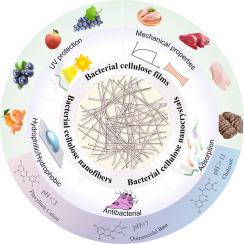Bacterial cellulose: Modification and application in food packaging
IF 12.5
1区 化学
Q1 CHEMISTRY, APPLIED
引用次数: 0
Abstract
Bacterial cellulose (BC) has entered the food packaging arena due to its excellent mechanical performance, good biocompatibility and degradability. In recent decades, researchers have conducted extensive research on the cultivation and improvement of BC. This review provides a comprehensive overview of the recent advances in the functional modification of BC and its applications in food packaging. First, we summarized the latest research progress in enhancing BC production, regulating its structure, and endowing it with antibacterial properties, ultraviolet (UV) protection, controllable wettability, efficient adsorption, and enhanced mechanical properties through physical, chemical, and biological methods. Meanwhile, we discussed the potential risks of BC modification to food safety. Furthermore, we focused on the application of functionalized BC in food preservation packaging and intelligent packaging films, demonstrating its great potential in active preservation and real-time monitoring of food quality. Finally, we prospected the future development direction of modified BC, pointing out that the development of green, efficient, and safe large-scale modification technologies is the key to its commercial application. This paper provides theoretical references and application guidance for the development of BC-based high-performance food packaging materials.

细菌纤维素:改性及其在食品包装中的应用
细菌纤维素(BC)以其优异的机械性能、良好的生物相容性和可降解性进入食品包装领域。近几十年来,研究人员对BC的培育和改良进行了广泛的研究。本文综述了近年来BC的功能改性及其在食品包装中的应用研究进展。首先,通过物理、化学和生物等方法,综述了提高BC生成、调节其结构、赋予其抗菌、防紫外线、可控润湿性、高效吸附和增强机械性能等方面的最新研究进展。同时讨论了BC改性对食品安全的潜在风险。此外,我们重点介绍了功能化BC在食品保鲜包装和智能包装薄膜中的应用,展示了其在主动保鲜和食品质量实时监控方面的巨大潜力。最后,展望了改性BC的未来发展方向,指出发展绿色、高效、安全的大规模改性技术是其商业化应用的关键。本文为bc基高性能食品包装材料的开发提供了理论参考和应用指导。
本文章由计算机程序翻译,如有差异,请以英文原文为准。
求助全文
约1分钟内获得全文
求助全文
来源期刊

Carbohydrate Polymers
化学-高分子科学
CiteScore
22.40
自引率
8.00%
发文量
1286
审稿时长
47 days
期刊介绍:
Carbohydrate Polymers stands as a prominent journal in the glycoscience field, dedicated to exploring and harnessing the potential of polysaccharides with applications spanning bioenergy, bioplastics, biomaterials, biorefining, chemistry, drug delivery, food, health, nanotechnology, packaging, paper, pharmaceuticals, medicine, oil recovery, textiles, tissue engineering, wood, and various aspects of glycoscience.
The journal emphasizes the central role of well-characterized carbohydrate polymers, highlighting their significance as the primary focus rather than a peripheral topic. Each paper must prominently feature at least one named carbohydrate polymer, evident in both citation and title, with a commitment to innovative research that advances scientific knowledge.
 求助内容:
求助内容: 应助结果提醒方式:
应助结果提醒方式:


